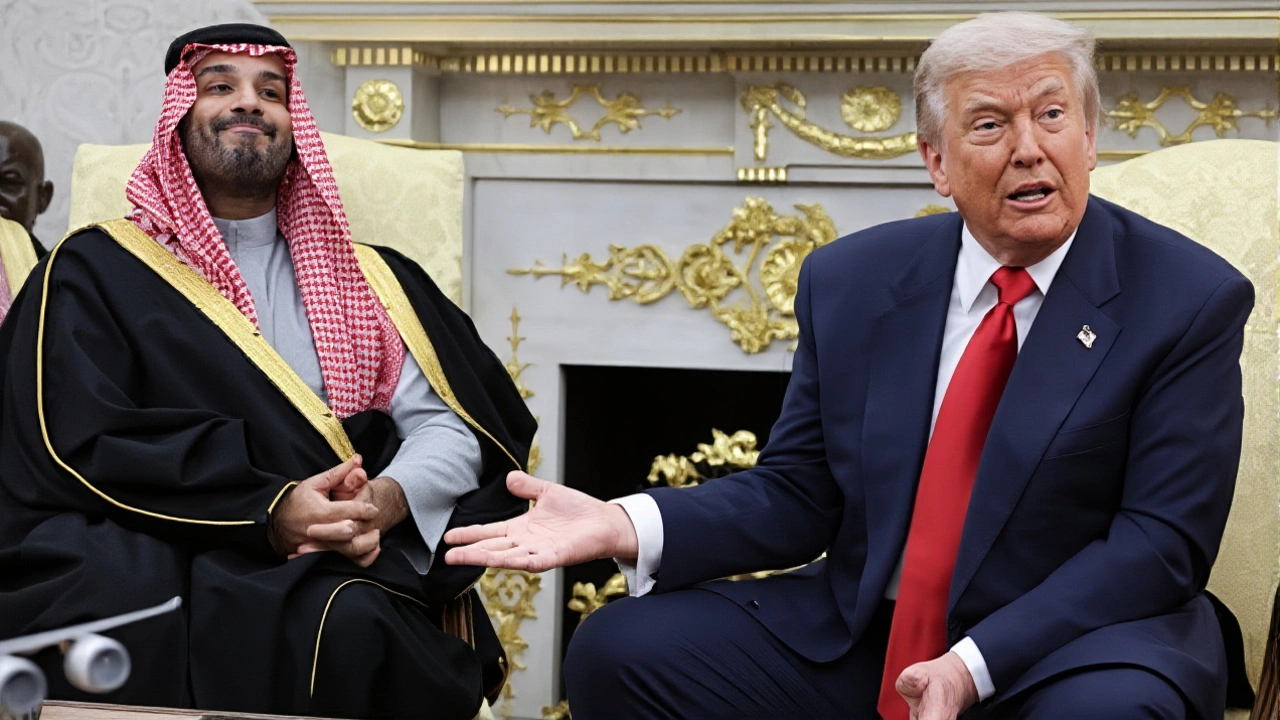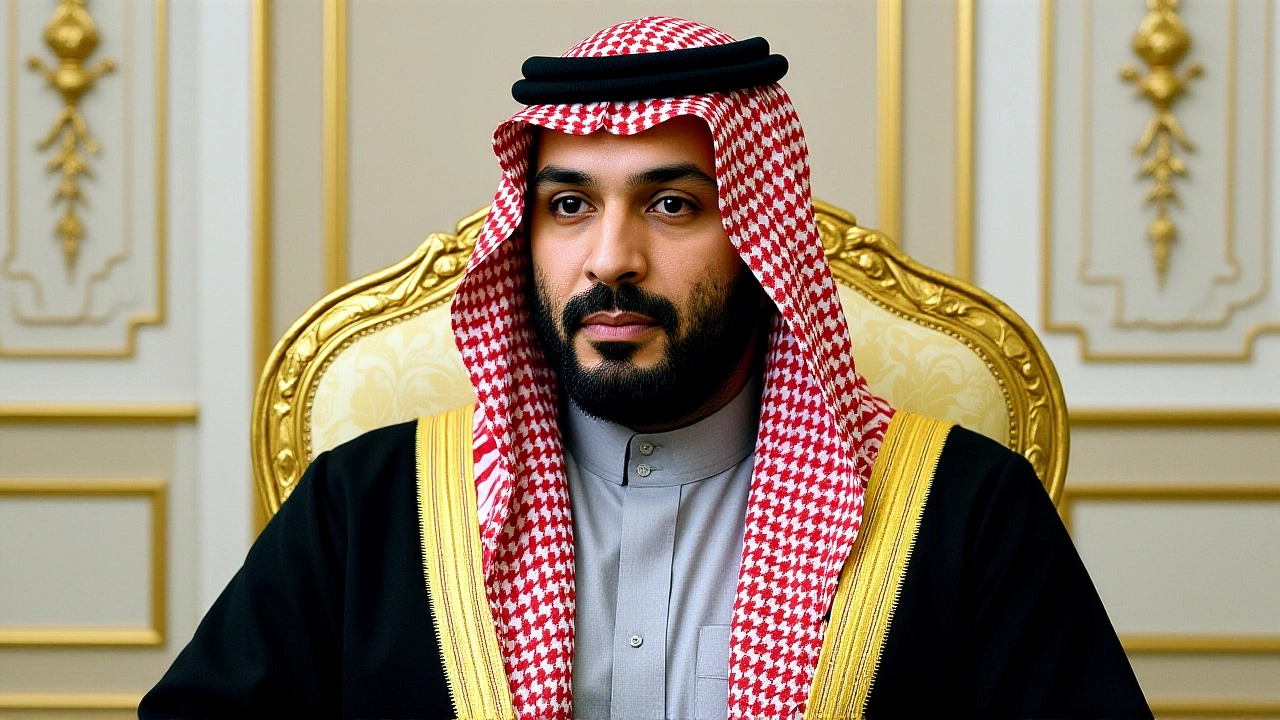Trump Announces $1 Trillion Saudi Investment Deal During Historic White House Visit
-
Nov, 20 2025
-
0 Komentar

When Donald J. Trump stepped onto the South Lawn of the White House on November 18, 2025, to bid farewell to Crown Prince Mohammed bin Salman, the air wasn’t just thick with protocol—it was charged with economic gravity. The official working visitWhite House had just produced what may be the largest foreign investment pledge in U.S. history: $1 trillion from the Kingdom of Saudi Arabia into American infrastructure, tech, and energy. And it wasn’t just a handshake deal—it was a statement. A recalibration. A new chapter in a relationship that’s shaped global oil markets, security alliances, and now, the future of American industry.
A Night That Broke the White House Record
The evening of November 18, 2025, will be etched into White House lore. In the East Room, 119 guests—diplomats, CEOs, defense contractors, and tech pioneers—dined under crystal chandeliers, many of them wearing Saudi thobes beside tailored tuxedos. President Trump, in his remarks, called it "a record for the room," adding that the space had "been clamoring for a ballroom" for 150 years. He joked about the approval timeline for renovations: "The process will take about uh would you say 24 hours? I think so." The crowd laughed. But beneath the humor was a serious signal: this wasn’t just a dinner. It was the unveiling of a new economic engine.
"Well, I said, could you try and get that up to a trillion dollars?" Trump told the gathering. "And yesterday, the crown prince announced that the number that they’ll be investing in the United States is $1 trillion. So, that’s really an honor." He didn’t specify exact sectors, but later White House aides confirmed the funds would flow into AI research labs, nuclear energy plants, semiconductor manufacturing, and defense tech hubs—particularly in Texas, Nevada, and Virginia.
The Deal Behind the Diplomacy
The $1 trillion isn’t cash on the table. It’s a 10-year commitment, structured through sovereign wealth vehicles like the Public Investment Fund (PIF) and private Saudi conglomerates. Analysts estimate roughly $400 billion will target U.S. tech infrastructure, $300 billion in clean energy—including hydrogen and small modular nuclear reactors—and $200 billion in defense systems, including Patriot missile upgrades and drone technology partnerships. The remaining $100 billion is earmarked for real estate and urban development projects in cities like Houston, Phoenix, and Detroit.
"This isn’t charity," said Dr. Linda Chen, an energy economist at the Brookings Institution. "It’s strategic. Saudi Arabia is betting that America’s industrial base, regulatory flexibility, and innovation ecosystem are still the best place to park capital. And Trump’s administration has made it clear: if you invest here, you get fast-tracked permits, tax incentives, and access to defense contracts. That’s a powerful formula."
What made this visit different from past Saudi trips was its breadth. Beyond economics, the two leaders discussed normalization of ties between Saudi Arabia and Israel—a long-simmering goal that gained momentum after the 2020 Abraham Accords. While no formal agreement was signed, both sides agreed to "accelerate confidential talks" under U.S. mediation. Defense cooperation also deepened, with Saudi Arabia reportedly agreeing to purchase 500 advanced F-35 fighter jets and co-develop AI-powered surveillance systems with U.S. firms like Palantir and Lockheed Martin.

Why This Matters to Every American
Think this only affects Wall Street? Think again. The $1 trillion pledge could create up to 1.2 million jobs over the next decade, according to a preliminary estimate by the U.S. Chamber of Commerce. That means more engineers in Ohio, construction workers in Arizona, and technicians in Michigan. Schools in tech corridors may soon see new STEM funding. Local governments are already scrambling to prepare zoning approvals.
"This is the kind of investment that doesn’t just build factories—it builds communities," said Mayor Teresa Ruiz of Detroit, whose city is in talks to host a $15 billion AI and robotics hub backed by Saudi capital. "We’re not waiting for Washington to lead. We’re building the future with Riyadh."
And yet, not everyone is cheering. Critics point to Saudi Arabia’s human rights record and question whether such a massive investment should come without conditions. "You can’t have a trillion-dollar partnership and ignore the fact that journalists are imprisoned and women’s rights are still restricted," said Sarah al-Mansoori, a human rights advocate based in London. "This deal rewards autocracy with access to American innovation. That’s a dangerous precedent."
What Comes Next?
The next 90 days will be critical. A joint U.S.-Saudi task force is expected to be formed by mid-December to oversee the investment pipeline. The Treasury Department will need to approve foreign ownership thresholds for sensitive tech assets. Meanwhile, Congress is already drafting legislation to create a "Strategic Foreign Investment Review Board"—a move that could reshape how future deals are vetted.
Trump has signaled he’ll push for legislative backing before the end of his term, which ends in January 2029. If passed, the deal could become a model for future alliances—with the UAE, Qatar, and even India watching closely.

Behind the Scenes: A Relationship Built on Trust
Trump and Mohammed bin Salman have known each other since 2017, when the Crown Prince first visited the White House as a rising star. Their bond is personal as much as political. Trump has called him "my friend," and the Crown Prince reportedly keeps a photo of the two shaking hands in his Riyadh office. That familiarity helped cut through bureaucratic red tape during this visit. One aide described the Oval Office talks as "less like negotiations, more like two old business partners deciding what to buy next."
The visit began on November 17, 2025, when the Crown Prince departed Riyadh under tight security, greeted by senior Saudi royals and ministers. His arrival at Andrews Air Force Base was met by Trump’s motorcade, followed by a ceremonial welcome at the White House. The next day’s agenda—bilateral lunch, East Room dinner, South Lawn farewell—was meticulously choreographed to project strength, unity, and ambition.
And it worked. On social media, #TrumpsSaudiDeal trended globally. Stock markets in New York and Riyadh surged. Oil prices dipped slightly—not from oversupply, but because investors now see Saudi Arabia as less reliant on oil revenues, and more as a global capital partner.
Frequently Asked Questions
How will the $1 trillion investment affect U.S. jobs?
The investment is projected to create up to 1.2 million jobs over ten years, primarily in high-tech manufacturing, energy infrastructure, and AI development. States like Texas, Nevada, and Michigan are already in negotiations for major hubs, with local governments preparing zoning changes and workforce training programs to absorb the influx of skilled labor.
What sectors will the Saudi investment target?
Approximately $400 billion will go to artificial intelligence and tech infrastructure, $300 billion to clean energy—including nuclear and hydrogen projects—and $200 billion to defense systems like F-35 jets and drone technology. The remaining $100 billion is slated for urban development, real estate, and transportation upgrades in key American cities.
Is this deal tied to Saudi-Israeli normalization?
While no formal agreement was signed, both leaders agreed to accelerate confidential talks on normalizing relations. The U.S. is acting as mediator, with senior diplomats from both sides holding backchannel meetings during the visit. The investment deal is widely seen as an incentive for Saudi Arabia to move toward diplomatic recognition of Israel.
Why is this considered historic?
It’s the largest single foreign investment pledge ever made to the U.S., dwarfing previous deals like the 2018 Saudi $20 billion investment in U.S. tech. Unlike past agreements, this one spans multiple critical sectors—energy, defense, AI—and includes long-term collaboration, not just purchases. It also reflects a strategic shift: Saudi Arabia is no longer just a buyer of American goods—it’s becoming a co-investor in America’s future.
What role did the White House dinner play in sealing the deal?
The black-tie dinner wasn’t just ceremonial—it was strategic. By gathering 119 top executives and officials in the East Room, Trump created an environment where business leaders from both nations could network informally. Several major deals were reportedly signed that night, including a $12 billion agreement between Aramco and a Texas-based nuclear reactor firm. The setting signaled trust, prestige, and long-term commitment.
Could this deal face political opposition in the U.S.?
Yes. Some lawmakers and human rights groups are already raising concerns about investing in a country with a poor human rights record. There are calls for a new Foreign Investment Review Board with ethical oversight. While the Trump administration is pushing for quick approval, Congress may delay funding or impose conditions, especially if the next president is from a different party.